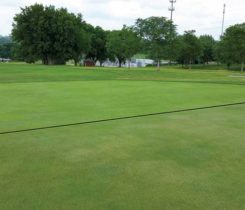Suppressing annual bluegrass in fairways with plant growth regulators
Cale Bigelow, Ph.D., is a turfgrass scientist at Purdue University. He has conducted numerous studies on annual bluegrass control with plant growth regulators and cultural practices. Cale can be reached at cbigelow@purdue.edu for more information.

Clark Throssell
Q: Briefly outline the application program of plant growth regulators (PGRs) for creeping bentgrass fairways in the Midwest.
We suggest using products that contain either Trimmit (paclobutrazol) or Cutless (flurprimidol) applied at the medium or high label rate every 21 days from mid-May to early October. Applications before mid-May or after early-October will sometimes discolor the turf. With this program we have had success in reducing annual bluegrass populations from 30 percent in spring of the first year to 5 percent in spring of the following year.
The good thing about these application programs is that annual bluegrass gradually fades out, the creeping bentgrass fills in and there are no bare spots.
An added benefit of any PGR program is the reduction in leaf growth, which helps with clipping management and provides flexibility during those difficult to mow, rainy periods.
If budgets are tight, an alternative would be to apply either Trimmit or Cutless as above, but only from late August to early October, when annual bluegrass seed is germinating. There will still be a reduction in the annual bluegrass population, just not as great as when applied all season long.
Q: How long should a superintendent stay on the PGR program?
There is no single answer to this question. Much depends on the size of the annual bluegrass seed bank in the soil. On older golf courses with a well-developed seed bank, or on courses with a substantial annual bluegrass population or both, follow the program every year.
Q: What are the similarities and differences between Trimmit and Cutless?
Both are effective PGRs, both are root absorbed and both need to be watered in after application. About the only difference is that in some years in some experiments, Trimmit may provide slightly — 2 percent to 5 percent — more reduction in annual bluegrass populations than Cutless. On the other hand, Cutless is less likely to discolor bentgrass than Trimmit and often is reported to cause less discoloration of cool-season rough surrounds where overspray occurs.
Q: What cultural practices do you recommend in conjunction with the PGR program to control annual bluegrass?
Roch Gaussion and Bruce Branham’s research showing that removing clippings helps reduces annual bluegrass populations, especially during spring seedhead production, still stands.
Cultivation to relieve soil compaction is a must. While there are as many cultivation programs as there are superintendents, some superintendents are deep-tine aerifying with solid tines in mid to late fall. Aerifying at this time upsets fewer golfers, and not pulling cores leaves the annual bluegrass seed buried in the soil.
Gaussion also showed that high annual nitrogen rates can promote annual bluegrass. If you want to use lower annual nitrogen rates, consider a spoon-feeding program. On an established fairway with reasonable soil organic matter (not thatch), apply 0.2 lbs. nitrogen per 1,000 sq. ft. every two weeks per month of the growing season. You can add soluble nitrogen in combination with your other spray applications.
Applying a preemergent herbicide in late August to control germinating annual bluegrass seed also is an option, but realize this may interfere with overseeding/interseeding practices.
Q: Anything else you would like to add?
Develop a realistic plan for annual bluegrass suppression, stick with it for several years and carefully evaluate the results at the same time each year before trying something else. Remember that annual bluegrass and creeping bentgrass populations in mixed stands will ebb and flow seasonally. Be cautious jumping on the latest control idea or product bandwagon. While you should fine-tune the plan, don’t make changes to your program every time you read a new idea or someone tells you what great success the superintendent down the road is having with their program. Lastly, remember annual bluegrass is a tenacious and adaptable plant, and “100 percent control” forever is unrealistic. The best we can expect is suppression.










